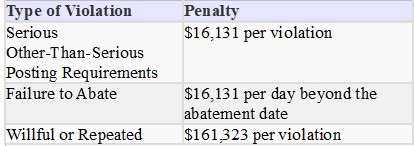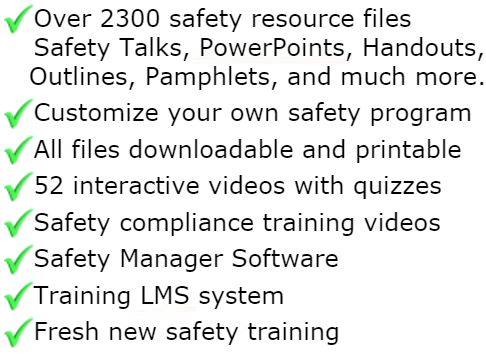
Electrical Safety
Electricity, even at very low voltages, can be hazardous. Under the right conditions, a 30 volt circuit can carry enough current to cause severe injury or death. An electrical shock occurs when your body comes in contact with a live electrical source, such as open electrical boxes, bare wires or from equipment that is not properly grounded.
Electrical safety in today's modern and technological environment is extremely important. Everywhere you go, machines, computers, tools, household items, everything runs on electricity. If electricity is properly controlled, it's very useful, but if you don't treat it with respect and follow the rules, it's very dangerous.
Electrical shock injuries are less severe when the current does not pass through or near nerve centers or vital organs. The majority of electrical injuries in industry, the electrical current flows from hands to feet. Since such a path involves both the heart and the lungs and are usually very serious.
Another type of injury is burns from electrical flashes. These burns are usually very deep and are slow to heal and can involve large areas of the body. Even persons at a reasonable distance from the arc can receive eye burns.
Quite a few injuries result from falls from one level to another caused by the worker receiving a shock from defective or malfunctioning equipment. That's the down side of electricity, but learning how to properly use and handle electricity will help reduce the risks.
The first step is to never use damaged or defective electrical tools or equipment. Tools and equipment must be in good working condition, with proper safeguards installed and working properly. This means you must inspect your equipment before using it.
Inspect it for frayed, cracked or cut cables, loose fittings on plugs and if a ground prong is required on the plug, it must be functioning properly. Let's quickly explain what this ground prong does.
On normal 110 volt equipment, there are three wires inside the cable. One is the hot wire, one is neutral and one is ground. The hot and neutral move electricity along the cable to provide the energy from the source to the tool. The third wire, or ground is there in case of a short or malfunction. If this occurs, the electricity then goes to ground, which means the electricity is transferred to this ground wire back to earth or ground. If this ground wire is missing, the electricity could flow through your body.
If you're using a grounded type tool and the ground prong is missing, you have no electrical protection in case something happens.
Inspect your tools and equipment to make sure all the cables are in good condition and the ground prong is in place and not missing. Don't use damaged electrical cords, plugs or equipment until it's been replaced or repaired. Never try to repair electrical cords by wrapping electrical tape around the cord. Frayed, cut or damaged cords must be replaced or repaired by a trained and authorized electrician.
All materials in the members area for this topic index

GET INSTANT ACCESS
to THE MEMBERS LIBRARY
Safety materials created by safety professionals.
Access to the Safety Manager software.
Wide variety of safety videos and courses.
**Brand New** Safety Training Management System
Pre-Made Safety Materials Ready For Use
Created by experienced safety professionals & risk consultants. Saving you time, money, and risk of injuries.
95% of the work already done.
Below are the maximum penalty amounts, with the annual adjustment for inflation, that may be assessed after Jan. 15, 2024. (See OSHA Memo, Jan. 8, 2024).

**New OSHA HEAT 90 DAY**
>>Download Free HERE<<
**New 2024 OSHA 300 Form**
>>Download Free HERE<<
**Brand New**
Free with full membership subscription
Training LMS System
Ask The Safety Consultant
Safety Equipment Deal Finder

“SafetyInfo.com is the first go-to website for safety professionals and companies to use in establishing a solid safety program"
-Mike McKenzie, Certified Safety & Health Manager (CSHM), McSafety Solutions™
Note: You must have a full subscription to the Safety Library in order to use this material. Any use outside of your organization, for resell, or without an active membership is strictly prohibited and may result in prosecution under copyright infringement laws. Please contact us first, if you would be interested in reselling or using our materials for reproduction.
Inside the Members Library
Topic Index
Accident Prevention
Air Quality
Asbestos
Bloodborne Pathogens
Boilers
Chemical Safety
Compressed Gas
Confined Space
Construction
Construction Worksite
Cranes & Slings
Driver / Fleet Safety
Drug Free Workplace
Electrical
Emergency Management
Engineering Safety
Environmental
Equipment
Ergonomics
Fall Protection
Fire Safety & Prevention
First Aid
Flammable Materials
Forklifts
Hazard Communication
Hazardous Materials
Hearing Protection
Heat Stress
Hot Work
Housekeeping
Job Safety Analysis
Laboratory
Ladders
Lead
Lockout-Tagout
Machinery & Equipment
Material Handling
MSDS (SDS)
Medical & First Aid
Occupational Health
Office Safety
Off the Job Safety
Personal Protection
Process Safety
Record Keeping
Respiratory Protection
Silica Safety
Rules & Policies
Signs & Labels
Slips, Trips & Fall
Training
Terrorism Programs
Tool Safety
Vehicle & Driver
Violence Programs
Welding & Hot Work
Training Videos
Library Index
Training Materials
Videos/Courses
Talks
Articles
PowerPoint
Handouts
Training Overheads
Quizzes
Supervisor Briefs
Management Briefs
Safety Sessions
2 Minute OSHA Safety Talks
Pamphlets
First Aid Training
Supervisor Training
Hazardous Materials
Bomb Threat
Crossword Puzzles
Biological Agents
Forms & Documents
Forms
Checklists
Audit Guides
Inspections Guides
Signs & Labels
Environmental Audit Guides
Recordkeeping - OSHA 300
Sign & Label Maker
Safety Management Resources
Safety Manuals/Written Programs
Ergonomic Programs
Emergency Plans
Process Safety Management
Construction Safety
Occupational Health
Environmental
Topic Sheets
DOT Fleet-Driver
Hazardous Materials
Chemical Safety
Drug Free Workplace
Terrorism Programs
Development Guides
Safety Manager Software
Safety References & Graphics
Technical Safety Information
Posters
Topic & Fact Sheets
Development Information
Job Specific Safety Rules
Terrorism
Calculators
Safety Comic Strips
New Safety Training System
Schedule and train your employees with our materials. Add unlimited amount of employees. Record all progress and issue certificates. For group and individual training sessions.

